Miracle Mile Blu-ray Movie
HomeMiracle Mile Blu-ray Movie 
Kino Lorber | 1988 | 88 min | Rated R | Jul 28, 2015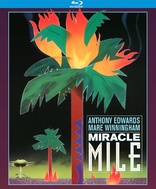
Movie rating
7.2 | / 10 |
Blu-ray rating
| Users | 0.0 | |
| Reviewer | 4.0 | |
| Overall | 4.0 |
Overview
Miracle Mile (1988)
A young man meets and falls in love with a young woman at the La Brea Tar Pits in Los Angeles. This area is known as Miracle Mile, and the whole movie takes place there. They make a date, which he misses, and while he is searching for her, he accidentally finds out that we (the United States) are about to start a nuclear war with the Soviet Union. He frantically searches for her so that they can escape Los Angeles.
Starring: Anthony Edwards, Mare Winningham, Robert DoQui, Denise Crosby, Mykelti WilliamsonDirector: Steve De Jarnatt
| Thriller | Uncertain |
| Drama | Uncertain |
| Romance | Uncertain |
| Action | Uncertain |
Specifications
Video
Video codec: MPEG-4 AVC
Video resolution: 1080p
Aspect ratio: 1.78:1
Original aspect ratio: 1.85:1
Audio
English: DTS-HD Master Audio 2.0 (48kHz, 16-bit)
Subtitles
None
Discs
50GB Blu-ray Disc
Single disc (1 BD)
Playback
Region A (C untested)
Review
Rating summary
| Movie | 5.0 | |
| Video | 4.0 | |
| Audio | 4.0 | |
| Extras | 4.5 | |
| Overall | 4.0 |
Miracle Mile Blu-ray Movie Review
It Only Takes a Moment
Reviewed by Michael Reuben July 27, 2015Not many people saw Miracle Mile during its brief theatrical run in May 1989, but those who did usually remember the experience, and the same holds true for fans who later discovered the film on VHS, laserdisc and DVD. Writer/director Steve De Jarnatt's second feature (and, to date, his most recent) is so unlike most American films before or since that it leaves a strong impression, even on viewers who don't like the experience (and they're a minority). Much of what makes Miracle Mile so memorable also makes it difficult to discuss with anyone who hasn't seen it. The film begins in one register, then subtly shifts into another, and finally veers off in yet a different direction that is wholly unexpected, but somehow De Jarnatt manages to sustain an underlying sense of coherence that can't be rationally explained, like the instinctive logic of a dream. Even though it's now become a period piece, the film still works. The technology, wardrobe and general circumstances belong to a bygone era, and the L.A. district where most of the film takes place has been renovated and rebuilt, but like so many great films, Miracle Mile draws viewers into its own eerily convincing world, which is timeless. If you have not yet seen Miracle Mile, but your curiosity is already piqued, then I suggest you stop reading now and seek out this new Kino Studio Classics Blu-ray, which is by far the best the film has ever looked outside the theater and contains a wealth of new and valuable extras. To the extent possible, the discussion below is spoiler-free, but Miracle Mile is best experienced with no advance knowledge. Begin with Anthony Edwards' voiceover and let it take you from there.
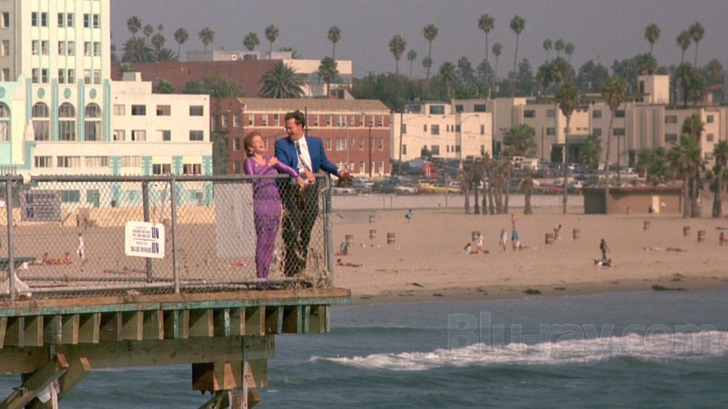
The core of Miracle Mile is a love story between Harry Washello (Anthony Edwards) and Julie Peters (Mare Winningham), who first see each other in L.A.'s natural history museum, where Harry keeps making a fool of himself by interrupting a school kids' tour with his own invented narration. Later, they encounter each other, as if by fate, at the La Brea Tar Pits and spend a magical afternoon together. Harry meets Julie's grandfather, Ivan (John Agar), and grandmother, Lucy (Lou Hancock), who haven't spoken in years but are both devoted to Julie. Julie and her grandfather listen to Harry play trombone in the jazz band with which he tours. Julie and Harry agree to meet late that night at Johnie's Coffee Shop on Fairfax in the Miracle Mile district, after Julie finishes her shift as a waitress. But a bizarre series of events conspires to make Harry miss the appointment. When he finally arrives at Johnie's, it is a few hours before dawn, and Julie has gone home to her grandmother's apartment. A friend and co-worker (O-Lan Jones) treats Harry with disdain. That's when Harry steps outside and makes the fateful decision to pick up the ringing phone in the booth outside Johnie's. The man at the other end, who thinks he has called his father but has misdialed, tells Harry that he works in a missile silo and nuclear war will commence in less than an hour. Harry is stunned. Is it a prank? Is it real? Could it be some sort of experiment in crowd psychology (a possibility that certainly seems plausible at various points along Miracle Mile's twisty path)? Harry knows only one thing for sure, which is that he must find Julie. For that, he has to re-enter Johnie's and get her address. In the process, he tells the entire crowd at the diner what he heard on the phone, and panic erupts throughout this motley crew of night owls, especially when one customer, a woman named Landa (Denise Crosby), seems to confirm Harry's story. Landa is curiously out of place, though. She wears formal business attire, carries a mobile phone (a rarity for that era), has immediate access to high-level government sources and immediately implements an evacuation plan. Who and what is she? Having already acquired a dreamy texture from the nighttime setting and the sudden change in tone, Miracle Mile now descends into a nightmare from which Harry cannot awake. Every force in the universe seem to conspire to frustrate his efforts, first, to find Julie and then to prevent them from reaching the top of the Mutual Benefit Life Building (known today simply as "5900 Wilshire"), where Landa has told Harry there will be a helicopter waiting to take them to the airport. Characters weave in and out of the story, either ignorant of what Harry has heard, or unwilling to help him, because they're more concerned for themselves, like Julie's boss, Fred (the late Robert DoQui, who was Sgt. Reed in the RoboCop films). Harry is often reduced to coercing assistance at gunpoint, as he does with a small-time thief and fence named Wilson (Mykelti Williamson). Panic and inexperience lead to encounters with the LAPD for which a previously law-abiding citizen like Harry is ill-prepared. All the while, the clock is ticking—a point that De Jarnatt isn't shy about emphasizing with such overt devices as a scene in which Harry and Julie find themselves in a wrecked department story literally surrounded by clocks. The terror of nuclear holocaust is more often associated with films of the Sixties (e.g., Fail Safe and Dr. Strangelove), but the standoff between the U.S. and the Soviet Union that ultimately led to the collapse of the latter in 1991 rekindled a similar underlying dread of global annihilation. It's easy to look back at history when one knows the outcome, but the people who are living it don't have that luxury. Americans of the Eighties could hope, but did not know for sure, that the aggressive strategy pursued by their government against the Soviets would ultimately prevail. Anyone who was raised on nuclear preparedness drills at school or who lived through the Cuban Missile Crisis could not help but feel a deep unease as the two heavily armed powers threatened, bluffed and strutted. De Jarnatt has said that he suffered from nightmares of nuclear war, and his achievement in Miracle Mile was to make that nightmare erupt into the middle of what at first seemed to be an everyday, small-scale romance—and then resolve it in a way no one ever would have expected, and anyone who has seen Miracle Mile will never forget.
Miracle Mile Blu-ray Movie, Video Quality 
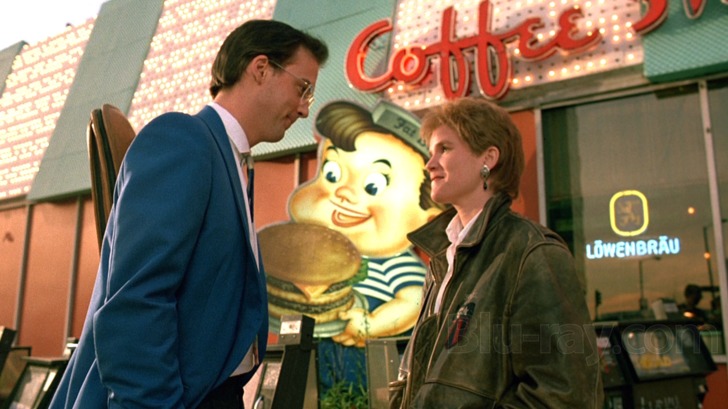
Miracle Mile was the first American film shot by Dutch cinematographer Theo Van de Sande, who has continued working in the U.S. ever since, photographing such diverse features as Blade and Cruel Intentions. In the commentary newly recorded for Kino's release, Van de Sande and De Jarnatt discuss many technical elements of the film's visual style, including the use of different film stocks for night and day photography and the avoidance of such classic techniques as wetting down the streets to diffuse light. The director and DP wanted a hard and unsentimental look for the film ("crystalline", in De Jarnatt's term). Kino's 1080p, AVC-encoded Blu-ray has been derived from what is apparently a new transfer, judging from remarks in the commentary, that has the approval of De Jarnatt and Van de Sande, although it does not sound like they oversaw the process. The source material is in relatively good shape, with occasional instance of scratches and dust, as well as the unavoidable flaws and deterioration caused by the use of opticals for special effects. Sharpness and detail are excellent and help to sustain the film's hallucinatory mood. Blacks are solid, and colors are vivid, beginning with the naturalistic hues of the first encounters between Harry and Julie, then progressing to the harsh, cold tones that dominate the night sequences, and finally graduating to the bright yellows, oranges and reds that predominate after the sun rises. The image is fine-grained and shows no signs of inappropriate digital tampering. In a departure from their usual practice, Kino has placed Miracle Mile on a BD-50, but this is primarily to accommodate the extras. Much of the disc remains unused, with a total image of only 25.9 GB. Nevertheless, the extra capacity has allowed Kino to master the film with an average bitrate of 24.16 Mbps, which is higher than the company's usual rate and allows for a superior, artifact-free presentation, especially late in the film, when there are several demanding sequences. One anomaly must be noted, and I cannot tell whether it is peculiar to the screener I reviewed or affects every disc. At timemark 1:18:34, just at the conclusion of an elevator ride, playback freezes for just a second, then resumes. The effect is similar to a layer change on a DVD. No part of the film is lost, but the effect is disconcerting.
Miracle Mile Blu-ray Movie, Audio Quality 
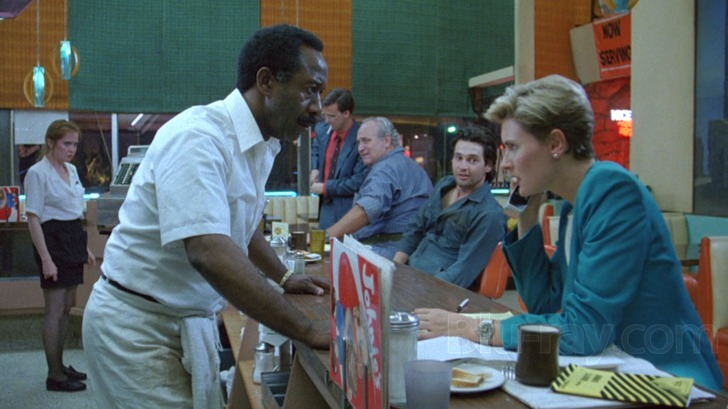
Miracle Mile was released in "Ultra Stereo", which was the generic version of Dolby Surround, and that original track is included on Blu-ray in lossless DTS-HD MA 2.0. When played back through a good ProLogic decoder, the track produces some impressive surround effects; for example, in a sequence near the end where Harry must pass beneath a crowded street through a huge drain pipe beneath the pavement, the soundtrack places the viewer inside the pipe. The dynamic range is sufficiently broad that numerous events (none of which can be described without spoilers) register with appropriate force and intensity. Dialogue is always clear, although some of it is deliberately overlapped and may not be fully heard until a second or third viewing. By far the most critical element of the soundtrack, however, is the musical score by Tangerine Dream. According to De Jarnatt, the principle contributors were founding member Edgar Froese (who died suddenly, just before the commentaries were recorded) and Paul Haslinger, who left the band not long after it composed Miracle Mile's soundtrack. The band's ability to create an enveloping sonic environment fits perfectly with De Jarnatt's approach to Miracle Mile as a waking nightmare, and this score is some of their finest work. (Portions evoke the band's earlier score for Risky Business, which, I suspect, is intentional.)
Miracle Mile Blu-ray Movie, Special Features and Extras 
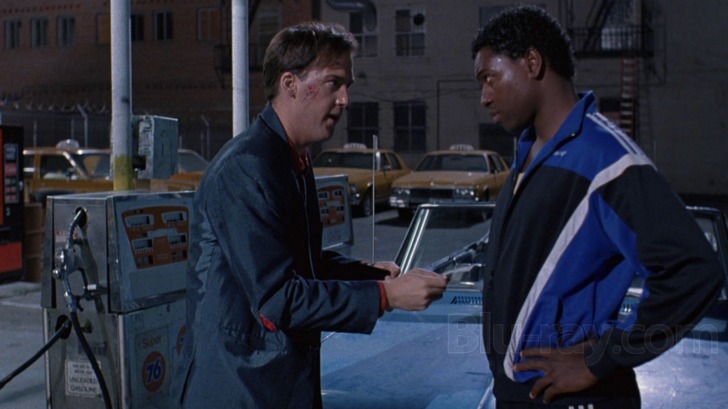
Kino has done yeoman's work in assembling members of the film's cast and crew to create an array of new supplements.
- Commentaries
- With Director Steve De Jarnatt and Film Critic Walter Chaw: Chaw writes for Film Freak Central and has published an entire book devoted to Miracle Mile. He and De Jarnatt discuss the film's imagery and themes and their relation both to De Jarnatt's other work (which, besides Cherry 2000, consists primarily of short fiction) and to other films of the Eighties. Chaw is a fine interviewer, one who uses his extensive knowledge to prompt the writer/director, then gets out of the way to let him speak.
- With Director Steve De Jarnatt, Director of Photography Theo Van de Sande and Production Designer Chris Horner: This commentary focuses on technique and logistics as De Jarnatt and his DP and designer recall the numerous ways they stretched a $3.7 million budget (plus additional funds contributed by the director himself) to create a film that looked like something much more expensive.
- Excavations from the Editing Room Tar Pits—Deleted Scenes, Outtakes & Bloopers (1080p; 1.33:1; 11:20): Subtitled "28 Year Old VHS Dailies", this compilation is referenced by De Jarnatt as a work-in-progress in the second of the two commentaries listed above. It includes a little of everything: alternate angles, scenes that were started and then abandoned, improvs and flubs. Of particular note is a scene discussed in the commentary featuring Joe Turkel (Dr. Tyrell in Blade Runner ) quoting Dante's Inferno.
- Supporting Cast & Crew Reunion (1080p; 1.78:1; 14:24): Rarely have so many supporting players from a film been gathered together over 25 years later. The reunion occurs at Johnie's. The participants are: Denise Crosby ("Landa"), Diane Delano ("Stewardess"), Alan Rosenberg ("Mike"), Kurt Fuller ("Gerstead"), Claude Earl Jones ("Harlan"), Jenette Goldstein ("Beverly Hills Chick #1"), O-Lan Jones ("Waitress"), Kelly Minter ("Charlotta"), Danny De La Paz ("Transvetite"), Brian Thompson ("Power Lifter"), Howard Swain ("Babbler", via Skype), Theo Van de Sande (DP) and De Jarnatt (writer/director).
- Harry & Julie: Interview with Stars Anthony Edwards and Mare Winningham (1080p; 1.78:1; 12:23): Interviewed together, the stars and long-time friends discuss their involvement in the project and why the film continues to resonate.
- Alternate Diamond Ending (1080p; 1.78:1; 4:30): This ending was appropriately abandoned, but it's an interesting concept.
- Trailers (1080p)
- Miracle Mile (1.78:1; 2:15)
- Cherry 2000 (1.85:1; 2:25)
Miracle Mile Blu-ray Movie, Overall Score and Recommendation 
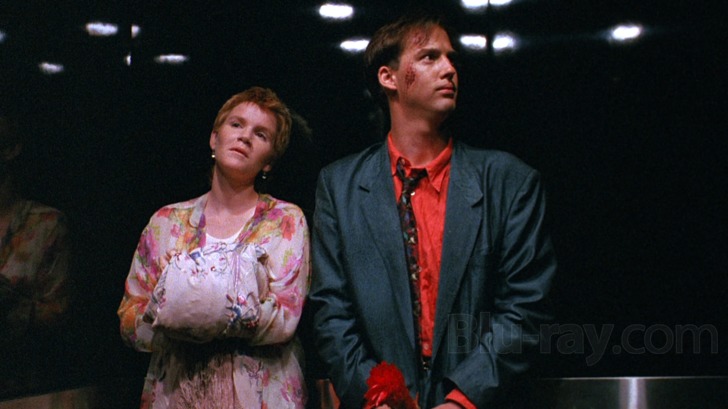
Some readers will no doubt question the high feature rating I have given Miracle Mile, to which I can only respond that I have great respect for films that catch viewers off-guard, show them familiar things in a new light, and then leave them with something serious on which to reflect. Miracle Mile does that (and more), but only because De Jarnatt insisted on sticking with his script, turning down offers of substantial funding that were contingent on major changes, and even buying back the rights at one point so that a studio could not meddle. Given a minuscule budget, De Jarnatt managed to make the film his way and do it so well that it still works over a quarter of a century later. With the caveat that there may be a glitch at a specified time mark (see "Video" above), Kino has done a splendid job of bringing Miracle Mile to Blu-ray and relating the story of its difficult path to the screen. Highly recommended.
Similar titles
Similar titles you might also like

The Man Who Finally Died
1963

The Stone Killer
Limited Edition to 3000
1973

Alcatraz Breakout
Alcatraz 1313-0
1978

The Hot Month of August
1966

Emergency Declaration
비상선언 / Bisang Seoneon
2021

Suburbia
Collector's Edition
1983

Earthquake 4K
1974

Bounty Killer
2013

Knife + Heart
Un couteau dans le cœur
2018

Crimes of Passion
1984

Johnny Chicano
1981

Thriller: A Cruel Picture
They Call Her One Eye
1973

City on Fire
1979

Deadly Prey
1987

Born Losers
1967

Airport 1975 4K
1974

White Fire
Vivre pour survivre
1985

Breathless 4K
Standard Edition
1983

The Big Doll House
1971

The End of Violence
1997
